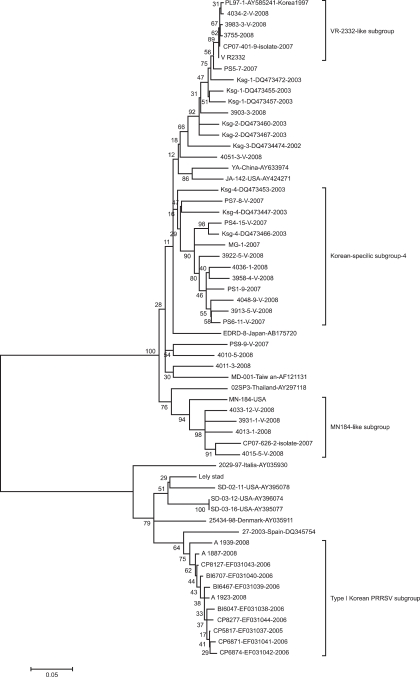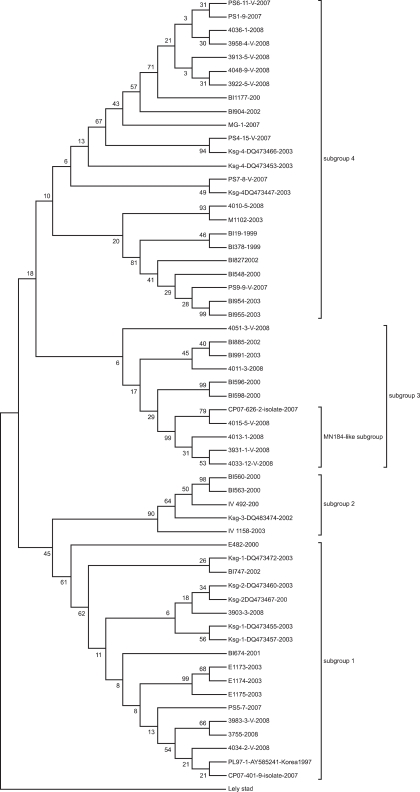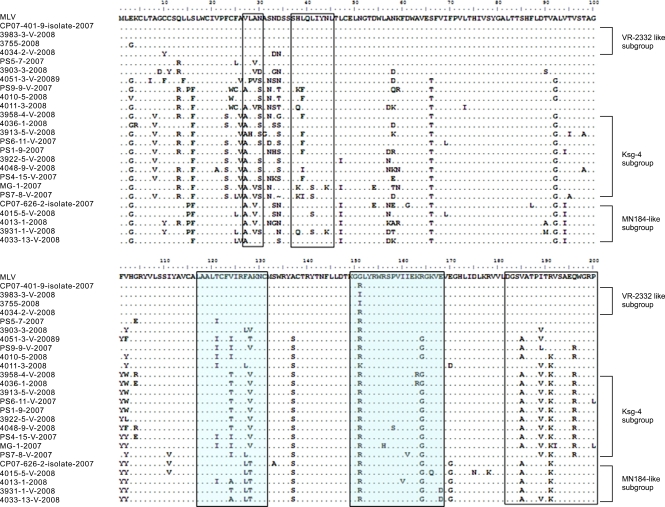J Vet Sci.
2009 Jun;10(2):121-130. 10.4142/jvs.2009.10.2.121.
Genetic analysis of ORF5 of recent Korean porcine reproductive and respiratory syndrome viruses (PRRSVs) in viremic sera collected from MLV-vaccinating or non-vaccinating farms
- Affiliations
-
- 1Department of Veterinary Medicine Virology Lab, College of Veterinary Medicine and BK21 Program for Veterinary Science, Seoul National University, Seoul 151-742, Korea. parkx026@snu.ac.kr
- 2Research Unit, Green Cross Veterinary Products, Yongin 449-903, Korea.
- 3Center for Infectious Diseases, Korea National Institute of Health, Seoul 122-701, Korea.
- KMID: 1102968
- DOI: http://doi.org/10.4142/jvs.2009.10.2.121
Abstract
- The 23 open reading frame (ORF) 5 sequences of Korean type II porcine reproductive and respiratory syndrome virus (PRRSV) were collected from viremic sera from the (modified live vaccine) MLV-vaccinating and non-vaccinating farms from 2007 to 2008. The samples were phylogenetically analyzed with previous ORF5 sequences, including type I Korean PRRSV, and previously reported or collected sequences from 1997 to 2008. A MN184-like subgroup of type II Korean PRRSV was newly identified in the viremic sera collected from 2007 to 2008. And of the type I PRRSVs, one subgroup had 87.2~88.9% similarity with the Lelystad virus, showing a close relationship with the 27~2003 strain of Spain. The maximum parsimony tree of type II PRRSV from 1997 to 2008 showed that they had evolved to four lineages, subgroups 1, 2, 3 and 4. Most of the recently collected type II PRRSVs belonged to subgroup 4 (48%). The region of three B-cell epitopes and two T-cell epitopes of ORF5 amino acids sequences was considerably different from the MLV in subgroups 3 and 4. In conclusion, the existence of type I PRRSV, which was genetically different from Lelystad virus (Prototype of type I PRRSV), and heterologous type II PRRSVs of viremic pigs detected even in the MLV-vaccinating farms indicated the need for new vaccine approaches for the control of PRRSV in Korea.
Keyword
- ORF5; phylogenetic; PRRSV; type; viremia
MeSH Terms
-
Animals
Epitopes, B-Lymphocyte/immunology
Epitopes, T-Lymphocyte/immunology
Evolution, Molecular
Korea
*Open Reading Frames
Phylogeny
Pilot Projects
Porcine Reproductive and Respiratory Syndrome/blood/genetics/immunology/*virology
Porcine respiratory and reproductive syndrome virus/*genetics/immunology
RNA, Viral/chemistry/genetics
Reverse Transcriptase Polymerase Chain Reaction/veterinary
Swine
Viral Vaccines/immunology/standards
Viremia/genetics/immunology/virology
Figure
Reference
-
1. Allan GM, McNeilly F, Ellis J, Krakowka S, Meehan B, McNair I, Walker I, Kennedy S. Experimental infection of colostrum deprived piglets with porcine circovirus 2 (PCV2) and porcine reproductive and respiratory syndrome virus (PRRSV) potentiates PCV2 replication. Arch Virol. 2000; 145:2421–2429. PMID: 11205128.
Article2. An DJ, Roh IS, Song DS, Park CK, Park BK. Phylogenetic characterization of porcine circovirus type 2 in PMWS and PDNS Korean pigs between 1999 and 2006. Virus Res. 2007; 129:115–122. PMID: 17706315.
Article3. Andreyev VG, Wesley RD, Mengeling WL, Vorwald AC, Lager KM. Genetic variation and phylogenetic relationships of 22 porcine reproductive and respiratory syndrome virus (PRRSV) field strains based on sequence analysis of open reading frame 5. Arch Virol. 1997; 142:993–1001. PMID: 9191863.
Article4. Benfield DA, Nelson E, Collins JE, Harris L, Goyal SM, Robison D, Christianson WT, Morrison RB, Gorcyca D, Chladek D. Characterization of swine infertility and respiratory syndrome (SIRS) virus (isolate ATCC VR-2332). J Vet Diagn Invest. 1992; 4:127–133. PMID: 1616976.
Article5. Cano JP, Dee SA, Murtaugh MP, Pijoan C. Impact of a modified-live porcine reproductive and respiratory syndrome virus vaccine intervention on a population of pigs infected with a heterologous isolate. Vaccine. 2007; 25:4382–4391. PMID: 17451850.
Article6. Cavanagh D. Nidovirales: A new order comprising Coronaviridae and Arteriviridae. Arch Virol. 1997; 142:629–633. PMID: 9349308.7. Cha SH, Choi EJ, Park JH, Yoon SR, Song JY, Kwon JH, Song HJ, Yoon KJ. Molecular characterization of recent Korean porcine reproductive and respiratory syndrome (PRRS) viruses and comparison to other Asian PRRS viruses. Vet Microbiol. 2006; 117:248–257. PMID: 16797883.
Article8. Cheon DS, Chae C. Antigenic variation and genotype of isolates of porcine reproductive and respiratory syndrome virus in Korea. Vet Rec. 2000; 147:215–218. PMID: 10994923.
Article9. Collins JE, Benfield DA, Christianson WT, Harris L, Hennings JC, Shaw DP, Goyal SM, McCullough S, Morrison RB, Joo HS, Gorcyca D, Chladek D. Isolation of swine infertility and respiratory syndrome virus (isolate ATCC VR-2332) in North America and experimental reproduction of the disease in gnotobiotic pigs. J Vet Diagn Invest. 1992; 4:117–126. PMID: 1616975.
Article10. Conzelmann KK, Visser N, Van Woensel P, Thiel HJ. Molecular characterization of porcine reproductive and respiratory syndrome virus, a member of the arterivirus group. Virology. 1993; 193:329–339. PMID: 8438574.
Article11. de Lima M, Pattnaik AK, Flores EF, Osorio FA. Serologic marker candidates identified among B-cell linear epitopes of Nsp2 and structural proteins of a North American strain of porcine reproductive and respiratory syndrome virus. Virology. 2006; 353:410–421. PMID: 16843516.
Article12. Harms PA, Sorden SD, Halbur PG, Bolin SR, Lager KM, Morozov I, Paul PS. Experimental reproduction of severe disease in CD/CD pigs concurrently infected with type 2 porcine circovirus and porcine reproductive and respiratory syndrome virus. Vet Pathol. 2001; 38:528–539. PMID: 11572560.
Article13. Johnson W, Roof M, Vaughn E, Christopher-Hennings J, Johnson CR, Murtaugh MP. Pathogenic and humoral immune responses to porcine reproductive and respiratory syndrome virus (PRRSV) are related to viral load in acute infection. Vet Immunol Immunopathol. 2004; 102:233–247. PMID: 15507308.
Article14. Kapur V, Elam MR, Pawlovich TM, Murtaugh MP. Genetic variation in porcine reproductive and respiratory syndrome virus isolates in the midwestern United States. J Gen Virol. 1996; 77:1271–1276. PMID: 8683216.
Article15. Kim HS, Kwang J, Yoon IJ, Joo HS, Frey ML. Enhanced replication of porcine reproductive and respiratory syndrome (PRRS) virus in a homogeneous subpopulation of MA-104 cell line. Arch Virol. 1993; 133:477–483. PMID: 8257302.
Article16. Kim J, Chung HK, Chae C. Association of porcine circovirus 2 with porcine respiratory disease complex. Vet J. 2003; 166:251–256. PMID: 14550736.
Article17. Kim J, Jung K, Chae C. Prevalence of porcine circovirus type 2 in aborted fetuses and stillborn piglets. Vet Rec. 2004; 155:489–492. PMID: 15537144.18. Kim JY, Lee SY, Sur JH, Lyoo YS. Serological and genetic characterization of the European strain of the porcine reproductive and respiratory syndrome virus isolated in Korea. Korean J Vet Res. 2006; 46:363–370.19. Kim WI, Kim JJ, Cha SH, Yoon KJ. Different biological characteristics of wild-type porcine reproductive and respiratory syndrome viruses and vaccine viruses and identification of the corresponding genetic determinants. J Clin Microbiol. 2008; 46:1758–1768. PMID: 18272711.
Article20. Kono Y, Kanno T, Shimizu M, Yamada S, Ohashi S, Nakamine M, Shirai J. Nested PCR for detection and typing of porcine reproductive and respiratory syndrome (PRRS) virus in pigs. J Vet Med Sci. 1996; 58:941–946. PMID: 8915992.
Article21. Kweon CH, Kwon BJ, Lee HJ, Cho JJ, Hwang EK, Shin JH, Yoon YD, Kang YB, An SH, Kim YH, Huh W, Jun MH, Wensvoort G. Isolation of porcine reproductive and respiratory syndrome virus (PRRSV) in Korea. Korean J Vet Res. 1994; 34:77–83.22. Mardassi H, Mounir S, Dea S. Structural gene analysis of a Quebec reference strain or porcine reproductive and respiratory syndrome virus (PRRSV). Adv Exp Med Biol. 1995; 380:277–281. PMID: 8830492.23. Meng XJ, Paul PS, Halbur PG. Molecular cloning and nucleotide sequencing of the 3'-terminal genomic RNA of the porcine reproductive and respiratory syndrome virus. J Gen Virol. 1994; 75:1795–1801. PMID: 8021610.
Article24. Meng XJ, Paul PS, Halbur PG, Lum MA. Phylogenetic analyses of the putative M (ORF 6) and N (ORF 7) genes of porcine reproductive and respiratory syndrome virus (PRRSV): implication for the existence of two genotypes of PRRSV in the U.S.A. and Europe. Arch Virol. 1995; 140:745–755. PMID: 7794115.
Article25. Meng XJ, Paul PS, Halbur PG, Morozov I. Sequence comparison of open reading frames 2 to 5 of low and high virulence United States isolates of porcine reproductive and respiratory syndrome virus. J Gen Virol. 1995; 76:3181–3188. PMID: 8847527.
Article26. Meulenberg JJ, Petersen-den Besten A, de Kluyver EP, Moormann RJ, Schaaper WM, Wensvoort G. Characterization of structural proteins of Lelystad virus. Adv Exp Med Biol. 1995; 380:271–276. PMID: 8830491.27. Meulenberg JJ, den Besten AP, de Kluyver E, van Nieuwstadt A, Wensvoort G, Moormann RJM. Molecular characterization of Lelystad virus. Vet Microbiol. 1997; 55:197–202. PMID: 9220614.
Article28. Murtaugh MP, Elam MR, Kakach LT. Comparison of the structural protein coding sequences of the VR-2332 and Lelystad virus strains of the PRRS virus. Arch Virol. 1995; 140:1451–1460. PMID: 7661696.
Article29. Oleksiewicz MB, Bøtner A, Madsen KG, Storgaard T. Sensitive detection and typing of porcine reproductive and respiratory syndrome virus by RT-PCR amplification of whole viral genes. Vet Microbiol. 1998; 64:7–22. PMID: 9874099.
Article30. Oleksiewicz MB, Bøtner A, Nielsen J, Storgaard T. Determination of 5'-leader sequences from radically disparate strains of porcine reproductive and respiratory syndrome virus reveals the presence of highly conserved sequence motifs. Arch Virol. 1999; 144:981–987. PMID: 10416379.
Article31. Ostrowski M, Galeota JA, Jar AM, Platt KB, Osorio FA, Lopez OJ. Identification of neutralizing and nonneutralizing epitopes in the porcine reproductive and respiratory syndrome virus GP5 ectodomain. J Virol. 2002; 76:4241–4250. PMID: 11932389.
Article32. Plagemann PGW. The primary GP5 neutralization epitope of North American isolates of porcine reproductive and respiratory syndrome virus. Vet Immunol Immunopathol. 2004; 102:263–275. PMID: 15507310.
Article33. Rovira A, Balasch M, Segalés J, García L, Plana-Durán J, Rosell C, Ellerbrok H, Mankertz A, Domingo M. Experimental inoculation of conventional pigs with porcine reproductive and respiratory syndrome virus and porcine circovirus 2. J Virol. 2002; 76:3232–3239. PMID: 11884547.
Article34. Scortti M, Prieto C, Martínez-Lobo FJ, Simarro I, Castro JM. Effects of two commercial European modified-live vaccines against porcine reproductive and respiratory syndrome viruses in pregnant gilts. Vet J. 2006; 172:506–514. PMID: 16169756.
Article35. Shen S, Kwang J, Liu W, Liu DX. Determination of the complete nucleotide sequence of a vaccine strain of porcine reproductive and respiratory syndrome virus and identification of the Nsp2 gene with a unique insertion. Arch Virol. 2000; 145:871–883. PMID: 10881675.
Article36. van Woensel PA, Liefkens K, Demaret S. Effect on viraemia of an American and a European serotype PRRSV vaccine after challenge with European wild-type strains of the virus. Vet Rec. 1998; 142:510–512. PMID: 9618874.
Article37. van Woensel PA, Liefkens K, Demaret S. European serotype PRRSV vaccine protects against European serotype challenge whereas an American serotype vaccine does not. Adv Exp Med Biol. 1998; 440:713–718. PMID: 9782349.
Article38. Vashisht K, Goldberg TL, Husmann RJ, Schnitzlein W, Zuckermann FA. Identification of immunodominant T-cell epitopes present in glycoprotein 5 of the North American genotype of porcine reproductive and respiratory syndrome virus. Vaccine. 2008; 26:4747–4753. PMID: 18590788.
Article39. Wensvoort G. Lelystad virus and the porcine epidemic abortion and respiratory syndrome. Vet Res. 1993; 24:117–124. PMID: 8343802.40. Wensvoort G, Terpstra C, Pol JMA, ter Laak EA, Bloemraad M, de Kluyver EP, Kragten C, van Buiten L, den Besten A, Wagenaar F, Broekhuijsen JM, Moonen PLJM, Zetstra T, de Boer EA, Tibben HJ, de Jong MF, Vant Veld P, Groenland GJR, van Gennep JA, Voets MT, Verheijden JHM, Braamskamp J. Mystery swine disease in the Netherlands: the isolation of Lelystad virus. Vet Q. 1991; 13:121–130. PMID: 1835211.
Article41. Wootton S, Yoo D, Rogan D. Full-length sequence of a Canadian porcine reproductive and respiratory syndrome virus (PRRSV) isolate. Arch Virol. 2000; 145:2297–2323. PMID: 11205119.
Article
- Full Text Links
- Actions
-
Cited
- CITED
-
- Close
- Share
- Similar articles
-
- Genetic diversity of porcine reproductive and respiratory syndrome virus in Korea
- Acute porcine reproductive and respiratory syndrome outbreaksin immunized sow herds: from occurrence to stabilization under whole herd vaccination strategy
- Sequence Analysis and Expression of ORF5 in Korean Isolate of Porcine Reproductive and Respiratory Syndrome Virus
- A survey of porcine reproductive and respiratory syndrome among wild boar populations in Korea
- Genetic diversity and phylogenetic analysis of porcine reproductive and respiratory syndrome virus in southern China from 2007 to 2014




